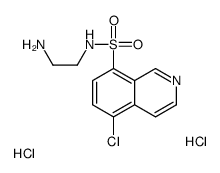1177141-67-1
| Name | N-(2-Aminoethyl)-5-chloroisoquinoline-8-sulfonamide Dihydrochloride |
|---|---|
| Synonyms |
N-(2-Aminoethyl)-5-chloroisoquinoline-8-sulphonamide dihydrochloride
CKI-7 dihydrochloride N-(2-Aminoethyl)-5-chloro-8-isoquinolinesulfonamide dihydrochlori de |
| Description | CKI-7 is a potent and ATP-competitive casein kinase 1 (CK1) inhibitor with an IC50 of 6 μM and a Ki of 8.5 μM. CKI-7 is a selective Cdc7 kinase inhibitor. CKI-7 also inhibits SGK, ribosomal S6 kinase-1 (S6K1) and mitogen- and stress-activated protein kinase-1 (MSK1). CKI-7 has a much weaker effect on casein kinase II and other protein kinases[1][2][3][4]. |
|---|---|
| Related Catalog | |
| Target |
CK1:6 μM (IC50) CK1:8.5 μM (Ki) Cdc7 SGK S6K1 MSK1 |
| In Vitro | CKI-7 (0.1-10 μM; 5 days; ES cells) treatment significantly increases the expression of the early neuroectodermal marker Sox1 and the number of cells positive for the neural markers nestin and βIII-tubulin, in a concentration-dependent manner[1]. CKI-7 (5 μM; 5 days; ES cells) treatment suppresses SFEB-induced β-catenin stabilization on day 5, indicating that CKI-7 inhibits Wnt signaling[1]. RT-PCR[1] Cell Line: Mouse ES cells Concentration: 0.1-10 μM Incubation Time: 5 days Result: Significantly increased the expression of the early neuroectodermal marker Sox1 and the number of cells positive for the neural markers nestin and βIII-tubulin, in a concentration-dependent manner. Western Blot Analysis[1] Cell Line: Mouse ES cells Concentration: 5 μM Incubation Time: 5 days Result: Suppressed SFEB-induced β-catenin stabilization on day 5. |
| In Vivo | In vivo dose-dependent anti-tumor activity of CKI-7 is demonstrated in a SCID-Beige mouse systemic tumor model utilzing a recently isolated Philadelphia chromosome positive acute lymphoblastic leukemia cell line. Standard cell cycle synchronization studies established that exposure to CKI-7 results in cell cycle dependent caspase 3 activation and apoptotic cell death[2]. |
| References |
| Molecular Formula | C11H14Cl3N3O2S |
|---|---|
| Molecular Weight | 358.67200 |
| Exact Mass | 356.98700 |
| PSA | 93.46000 |
| LogP | 4.90120 |
| Storage condition | -20°C |
| Symbol |

GHS06 |
|---|---|
| Signal Word | Danger |
| Hazard Statements | H301 |
| Precautionary Statements | P301 + P310 |
| Personal Protective Equipment | Eyeshields;Faceshields;Gloves;type P2 (EN 143) respirator cartridges |
| Hazard Codes | T+ |
| RIDADR | UN 2811 6.1 / PGIII |
| Hazard Class | 6.1 |
